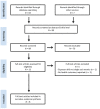Effects of Neonicotinoid Pesticide Exposure on Human Health: A Systematic Review
- PMID: 27385285
- PMCID: PMC5289916
- DOI: 10.1289/EHP515
Effects of Neonicotinoid Pesticide Exposure on Human Health: A Systematic Review
Abstract
Background: Numerous studies have identified detectable levels of neonicotinoids (neonics) in the environment, adverse effects of neonics in many species, including mammals, and pathways through which human exposure to neonics could occur, yet little is known about the human health effects of neonic exposure.
Objective: In this systematic review, we sought to identify human population studies on the health effects of neonics.
Methods: Studies published in English between 2005 and 2015 were searched using PubMed, Scopus, and Web of Science databases. No restrictions were placed on the type of health outcome assessed. Risk of bias was assessed using guidance developed by the National Toxicology Program's Office of Health Assessment and Translation.
Results: Eight studies investigating the human health effects of exposure to neonics were identified. Four examined acute exposure: Three neonic poisoning studies reported two fatalities (n = 1,280 cases) and an occupational exposure study of 19 forestry workers reported no adverse effects. Four general population studies reported associations between chronic neonic exposure and adverse developmental or neurological outcomes, including tetralogy of Fallot (AOR 2.4, 95% CI: 1.1, 5.4), anencephaly (AOR 2.9, 95% CI: 1.0, 8.2), autism spectrum disorder [AOR 1.3, 95% credible interval (CrI): 0.78, 2.2], and a symptom cluster including memory loss and finger tremor (OR 14, 95% CI: 3.5, 57). Reported odds ratios were based on exposed compared to unexposed groups.
Conclusions: The studies conducted to date were limited in number with suggestive but methodologically weak findings related to chronic exposure. Given the wide-scale use of neonics, more studies are needed to fully understand their effects on human health. Citation: Cimino AM, Boyles AL, Thayer KA, Perry MJ. 2017. Effects of neonicotinoid pesticide exposure on human health: a systematic review. Environ Health Perspect 125:155-162; http://dx.doi.org/10.1289/EHP515.
Conflict of interest statement
The authors declare they have no actual or potential competing financial interests.
Figures
Comment in
-
Catching Up with Popular Pesticides: More Human Health Studies Are Needed on Neonicotinoids.Environ Health Perspect. 2017 Feb 1;125(2):A41-A42. doi: 10.1289/ehp.125-A41. Environ Health Perspect. 2017. PMID: 28145869 Free PMC article. No abstract available.
References
-
- Abou-Donia MB, Goldstein LB, Bullman S, Tu T, Khan WA, Dechkovskaia AM, et al. Imidacloprid induces neurobehavioral deficits and increases expression of glial fibrillary acidic protein in the motor cortex and hippocampus in offspring rats following in utero exposure. J Toxicol Environ Health A. 2008;71(2):119–130. - PubMed
-
- Calderón-Segura ME, Gómez-Arroyo S, Villalobos-Pietrini R, Martínez-Velenzuela C, Carbajal-López Y, Calderón-Ezquerro Mdel C, et al. 2012. Evaluation of genotoxic and cytotoxic effects in human peripheral blood lymphocytes exposed in vitro to neonicotinoid insecticides news. J Toxicol 2012 612647, doi:10.1155/2012/612647 - DOI - PMC - PubMed
-
- Cao L, Chen B, Zheng L, Wang D, Liu F, Huang Q. Assessment of potential dermal and inhalation exposure of workers to the insecticide imidacloprid using whole-body dosimetry in China. J Environ Sci (China) 2015;1(27):139–146. - PubMed
Publication types
MeSH terms
Substances
Grants and funding
LinkOut - more resources
Full Text Sources
Other Literature Sources
Medical


